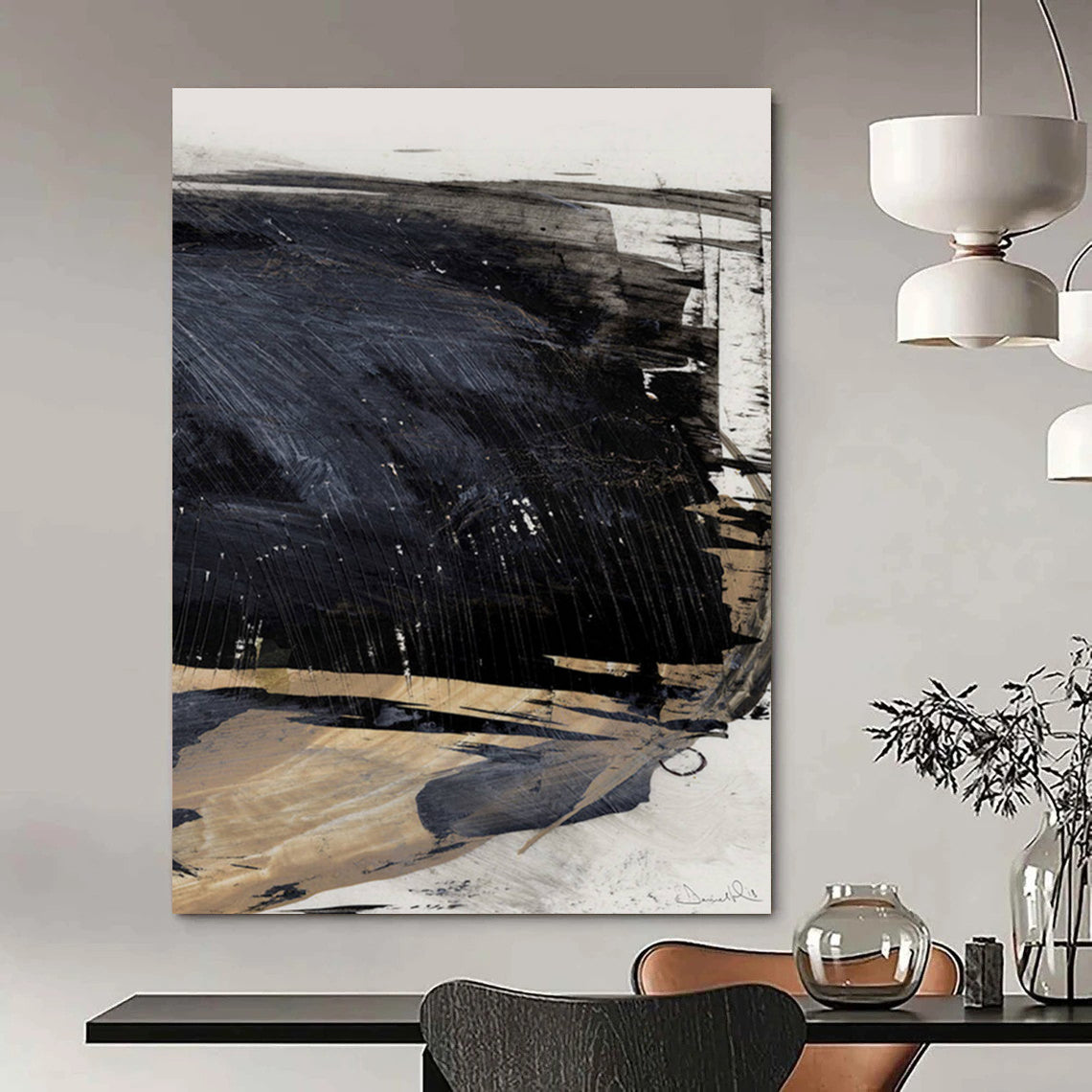In the realm of contemporary abstraction, few pieces capture the essence of quiet introspection and tactile depth quite like the White Textured Abstract Composition Painting for Contemporary Art Galleries HENG509. This captivating artwork presents a canvas dominated by soft, neutral tones—predominantly whites, beiges, and subtle grays—arranged in irregular, fragmented layers that evoke the appearance of cracked earth or weathered stone. The composition eschews any representational forms, instead relying on thick impasto techniques to build a surface that invites touch, with jagged edges and overlapping slabs creating a sense of organic disintegration and reformation. At first glance, the painting appears almost monochromatic, but closer inspection reveals nuanced variations in shade and texture, where lighter creams blend into deeper taupes, fostering an illusion of depth amid apparent flatness. This deliberate ambiguity draws viewers into a meditative state, encouraging personal interpretation while subtly referencing natural phenomena like eroded landscapes or the passage of time.

The visual analysis of this piece begins with its core elements: color, texture, and form. The predominant white palette symbolizes purity and emptiness, allowing the viewer's mind to fill the voids with their own narratives. As explored in discussions of color psychology, white often evokes feelings of calmness and clarity, reducing visual clutter to promote mental peace—qualities that make this painting particularly suited for serene environments. The textured application, achieved through heavy layers of paint, adds a sculptural quality, transforming the two-dimensional canvas into something almost three-dimensional. This technique aligns with broader traditions in abstract art, where artists prioritize sensory experience over literal depiction, using materiality to convey emotion. The fragmented forms suggest a narrative of fragmentation and unity, perhaps mirroring life's impermanence, with dark accents punctuating the lighter expanses like shadows in a vast, ethereal space.
Delving deeper into the artist's background, Heng Li, the creator behind the HENG509 series, is a contemporary abstract painter whose work is deeply influenced by his multicultural roots and philosophical explorations. Born in Shanghai and later relocating to New York, Li's journey into abstraction began in the early 2010s after a decade spent in traditional landscape painting. Disillusioned by the constraints of realism, he shifted toward non-representational forms, drawing inspiration from Eastern concepts of wabi-sabi—the beauty in imperfection and transience—and Western modernist movements. Li's creation ideology revolves around the pursuit of "silent harmony," where he views art as a bridge between chaos and order. In interviews, he has described his process as meditative, starting with broad, gestural applications of neutral pigments before meticulously layering and scraping to reveal underlying textures. For the White Textured Abstract Composition Painting for Contemporary Art Galleries HENG509, Li aimed to capture the essence of "whispered resilience," using white as a metaphor for blank slates amid life's fractures. His evolution from figurative to abstract work was marked by a pivotal 2018 exhibition in Beijing, where he experimented with impasto to evoke geological formations, a theme that has since defined his oeuvre. This piece, part of his ongoing series on neutral abstractions, reflects his belief that true beauty emerges from subtlety, encouraging viewers to find solace in the understated.
This approach resonates with historical precedents in abstract art, where pioneers emphasized the intrinsic power of form and material to evoke spiritual or emotional responses. Li's textured methodology echoes the gestural freedom of mid-20th-century artists, yet he innovates by incorporating sustainable, eco-friendly mediums, aligning his practice with modern environmental consciousness. The painting's versatility shines in professional settings, making it an exemplary choice for Office Wall Art, where its calming presence can enhance productivity and foster a balanced atmosphere. Beyond aesthetics, the work's psychological benefits—rooted in the soothing effects of neutral tones—make it a thoughtful addition to spaces designed for focus and reflection.

Enthusiasts and collectors have consistently praised the transformative impact of this piece. For instance, interior designer Emily Carter notes, "The HENG509 completely elevated my client's minimalist office; its subtle textures add depth without overwhelming the space—it's like a breath of fresh air." Similarly, art collector Michael Reyes shares, "As someone who appreciates quiet elegance, this painting spoke to me instantly. Hanging it in my home study has made my daily routines more centered and inspired." Another buyer, Sophia Nguyen, adds, "I was drawn to the organic feel of the layers—it reminds me of ancient ruins, yet it's so modern. Perfect for my gallery wall, and the quality is impeccable." These testimonials highlight how the artwork not only adorns walls but also enriches daily experiences, blending seamlessly into contemporary lifestyles.
Ultimately, the White Textured Abstract Composition Painting for Contemporary Art Galleries HENG509 stands as a testament to Heng Li's mastery in evoking profound simplicity. Through its textured abstraction, it invites ongoing discovery, proving that in the world of art, restraint can yield the most resonant expressions.
FAQ
What is the primary color scheme in this painting? The painting features a neutral palette dominated by whites, beiges, and soft grays, creating a serene and minimalist aesthetic.
How does the texture contribute to the artwork's impact? The thick impasto layers add a tactile, sculptural quality, evoking depth and inviting viewers to engage beyond the visual.
Who is the artist behind HENG509, and what inspires their work? Heng Li, a contemporary abstract painter, draws from wabi-sabi philosophy and natural forms to explore themes of harmony and impermanence.
Is this painting suitable for office environments? Yes, its calming tones and subtle design make it ideal for Office Wall Art, enhancing focus and professionalism.
How should I care for this textured abstract piece? Avoid direct sunlight to prevent fading, dust gently with a soft brush, and frame under UV-protective glass for longevity.
What makes this painting unique in abstract art? Its focus on neutral textures and fragmented forms offers a meditative experience, blending Eastern minimalism with Western abstraction.

